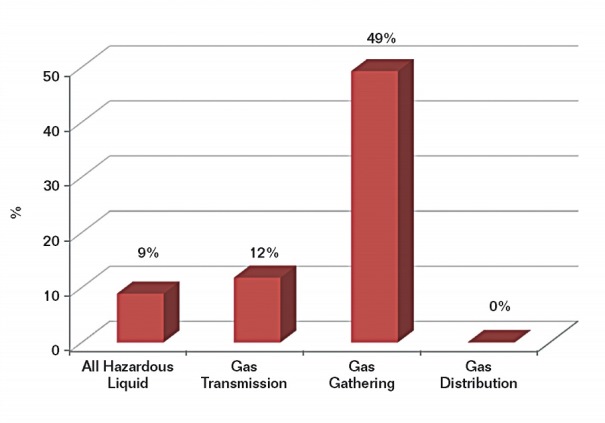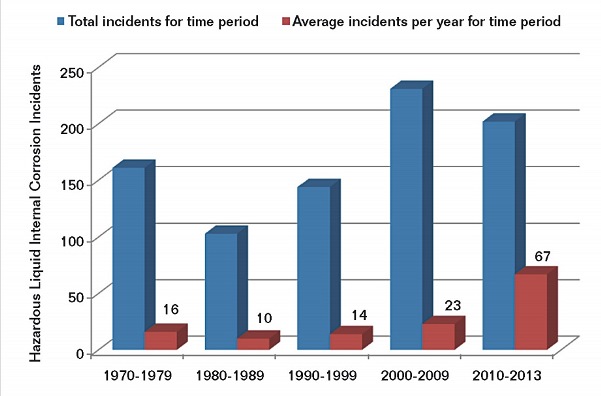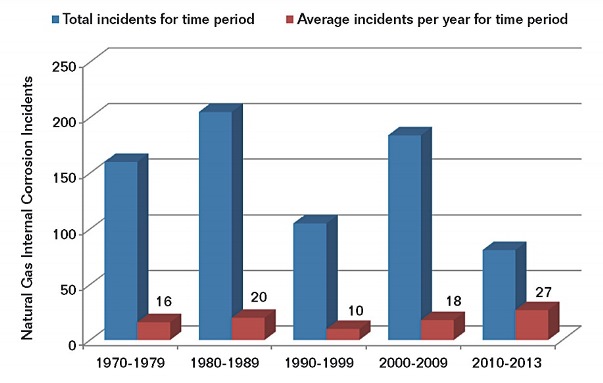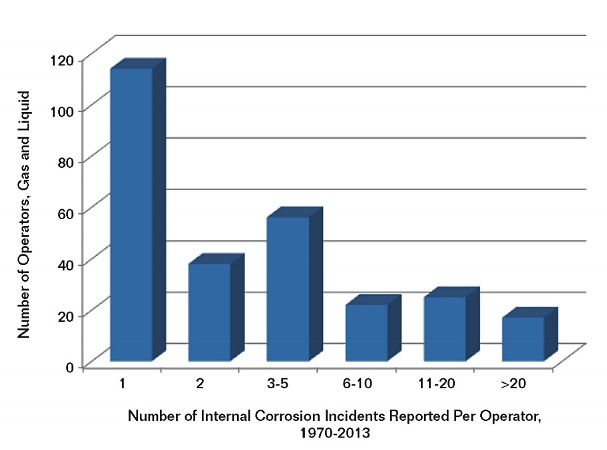In spite of improvements driven by the U.S. Pipeline Safety Improvement Act of 2002 and the added emphasis on integrity management, pipeline failures due to internal corrosion continue to occur. The U.S. Department of Transportation's Pipeline and Hazardous Materials Safety Administration (PHMSA) recently noted that 206 internal corrosion incidents were reported on regulated gas pipelines between 2002 and 2012, and new regulations are forthcoming that will increase the requirements for internal corrosion management.1 Data published by the Canadian Association of Petroleum Producers (CAPP) showed that the number of internal corrosion incidents per year in Alberta for sweet gas-gathering pipelines went from ~25 in 1985 to 125 in 2008,2 and from ~75 in 1985 to 175 in 2008 for oil effluent pipelines.3
By learning to prevent internal corrosion incidents, operators can reduce operating costs and exposure to business risks. In the recent NACE International IMPACT study,4 the global cost of corrosion was estimated at U.S. $2.5 trillion, with the ability to save from 15 to 35% of this cost using available corrosion-control practices. Pipeline leaks and ruptures resulting from internal corrosion increase risks associated with health, safety, the environment, and deliverability, and can result in regulatory actions and litigation against pipeline operators. This article examines some trends in reported incidents and discusses an analytical methodology based on root cause analysis (RCA) that operators can use to learn from incidents and reduce subsequent or repeated failures.

Internal Corrosion Incidents Continue
Internal corrosion incident data reported to PHMSA by regulated hazardous liquid and natural gas pipeline operators in the United States are available to the public.5 Based on these data, internal corrosion incidents from 1994 through 2013 are shown in Figure 1 as a percentage of all Department of Transportation (DOT) reported incident causes. For this time period, internal corrosion represented 9% of all hazardous liquid incidents, 12% of all gas transmission incidents, and 49% of all gas-gathering incidents.
The number of DOT-reported internal corrosion incidents from 1970 through 2013 for regulated hazardous liquid transportation pipelines and facilities and regulated natural gas pipelines and facilities are shown by decade in Figures 2 and 3, respectively. These figures also show the average number of internal corrosion incidents per year for each decade or time period.


Generally, the average numbers of internal corrosion incidents reported per year through the 1970s, 1980s, and 1990s were fairly consistent and similar for both hazardous liquid and natural gas pipeline systems. From 2000 through 2009, however, there was a notable increase in the number of internal corrosion incidents on hazardous liquid pipelines. The average number of incidents per year from 2010 through 2013 reached a high of 67, compared to 23 per year for the previous decade. A similar, but lesser trend was observed in the incidents for natural gas pipelines, with an average of 27 incidents per year from 2010 to 2013 vs. an average of 18 incidents per year for the previous decade. Considering that internal corrosion is a time-dependent threat, it is possible that the number of incidents could be increasing in part as a reflection of the aging pipeline infrastructure. This is particularly true if the threat is not effectively identified or mitigated.
Figure 4 shows the number of hazardous liquid and natural gas pipeline operators with one or more DOT-reported internal corrosion incidents from 1970 through 2013. These values were determined based on the operator identification number assigned by PHMSA and the number of incidents reported for that operator. A majority of both hazardous liquid and natural gas pipeline operators have reported more than one internal corrosion incident over this period of time. In some cases, operators have reported more than 20 internal corrosion incidents over this 43-year period. These data should be viewed in consideration of the fact that some large operators may operate thousands of miles of pipelines, and the assets owned by each operator are likely to have changed over the years through construction, decommissioning, mergers, acquisitions, and sales. The number of internal corrosion incidents shown in Figure 4 should not be interpreted as being repeat incidents on the same pipelines, although this appears to be true in some cases.

From 2004 through 2012, the total number of U.S. hazardous liquid pipeline miles increased by 11%, yet the frequency of internal corrosion incidents in 2012 was nearly three times greater than that in 2004. The total natural gas pipeline miles decreased ~2.5% over the same time period and the incident frequency also declined slightly. The data suggest that increases in total regulated pipeline miles are not a key factor in the increased frequency of internal corrosion incidents.
Learning from Incidents: Three Phases
Analyses performed to determine the causes of an incident can be based on the guidelines of the Systematic Causal Analysis Technique (SCAT) and the loss causation model.6 These tools are commonly used in evaluating safety management systems and process safety incidents. An RCA methodology can be performed in three successive phases following an event. Each phase of the analysis determines different information about the conditions that led to the failure and ways to prevent another incident. The terms “immediate cause,” “basic cause,” and “root cause” are often misused, and each term has a specific meaning as associated with each phase of the incident investigation.
Phase 1: Immediate Cause—Corrosion Mechanism
The first phase of the investigation involves determination of the immediate cause. For an internal corrosion failure, the immediate (or direct) cause of the failure relates to the findings of a metallurgical laboratory analysis performed on the failed pipe section or component. The laboratory analysis is used to determine the damage mechanism that caused the leak or failure. An example of an immediate cause is internal corrosion resulting from high levels of carbon dioxide (CO2) in a wet gas pipeline.
Failure analysis of sections removed from internally corroded pipelines can provide valuable information about the corrosion mechanisms that resulted in a corrosion incident. The corrosion mechanisms responsible for pipeline corrosion may be driven by corrosive gases (e.g., CO2, hydrogen sulfide [H2S], or oxygen [O2]), the presence of water and solid or sludge deposits, biofilms, high velocity or erosion, corrosive chemical species (e.g., acids), or some combination of factors. Laboratory analysis of the corroded pipe, including any liquid and solid samples collected from the pipeline, helps in identifying the chemical, microbiological, and physical conditions that supported the corrosion mechanism. Historical data on pipeline operating conditions, including process upsets, fluid composition monitoring, previous leaks or failures, internal corrosion mitigation measures, etc., are also helpful in interpreting the significance of laboratory test results.
Procedures and other guidance on conducting corrosion failure investigations are available in a number of references.7-8 Sample preservation is one of the most important concerns for obtaining meaningful data from corrosion failure analyses, since corrosion products and microorganisms can change/degrade rapidly upon exposure to air or other contaminants. The main steps in a corrosion failure investigation are listed in Table 1.

Phase 2: Basic Cause—Contributing Factors
The second phase of the investigation involves identification of the basic, or contributing, cause(s) of the failure. Basic causes are factors that contributed to the immediate cause. For example, where the immediate cause of internal corrosion is high CO2 in the gas, the contributing causes may include exceeding the capacity of the upstream gas processing equipment and inadequate corrosion inhibitor injection rates.
A forensic corrosion engineering approach9-10 may be used to understand the contributing causes and underlying mechanisms of the corrosion damage and apply this knowledge to help mitigate future corrosion threats. A fishbone diagram may be used to help evaluate different categories of possible contributing factors, such as people, equipment, measurement, materials, and environment. Often it turns out there is more than one basic cause of an incident, and in some cases a series of cascading events constitute the basic cause.
Phase 3: Root Cause—Management System Factors
True root cause analysis typically leads to a review of management systems to determine why the basic or contributing causes were not mitigated before the incident occurred. Root cause analysis often looks for systemic issues that, if addressed, would prevent a similar incident from occurring in the future. Continuing with the high CO2 gas pipeline example, if a corrosion management system were in place, the organization would have requirements for maintenance planning and procedures, and programs to ensure personnel were trained in those procedures. The management system would also require feedback from gas quality monitoring to ensure that maintenance was being performed correctly and that the gas processing equipment was operating properly.
Many in the oil and gas industry are familiar with pipeline integrity management systems. Standards and regulations on integrity management11-12 identify the management system components that support integrity management activities, such as:
• Policies
• Planning and administration
• Risk evaluation and management
• Compliance assurance
• Project management
• Training and competence
• Communications and data management
• Asset management
• Contractor management and purchasing
• Emergency preparedness
• Learning from events
U.S. Regulations
Discovery of internal corrosion, regardless of whether it affects pipeline integrity, suggests that potentially corrosive species are being (or have been) transported. When corrosion is observed, its cause should be investigated since regulations require operators to take actions to minimize internal corrosion.13 To minimize corrosion, the cause must be known.
PHMSA Advisory Bulletin ADB-08-0814 advises operators of hazardous liquid transmission pipelines to review and analyze numerous factors to determine whether internal corrosion is a threat. The bulletin notes that operators must maintain a detailed record of the analysis to demonstrate the adequacy of corrosion control measures or that corrosion control measures are not necessary. The bulletin also emphasizes the need for operators to periodically reassess the internal corrosion threats to their system and document the results. An internal corrosion health check process for performing and documenting such a review has been proposed.15
Under U.S. pipeline regulations, operators are also required to establish procedures for analyzing accidents and failures, including the selection of samples for laboratory examination, where appropriate, to determine the cause of the failure and to minimize the possibility of a recurrence. The use of the RCA methodology is certainly one way to increase organizational learning by developing a clear understanding of the causes of an incident. PHMSA’s Integrity Management Inspection Protocols for hazardous liquid pipelines specifically mention the need for an effective RCA program and implementation of lessons learned.16 The language in the protocol states that an operator’s RCA program should address:
1. “Rigorous and complete analyses of the problems affecting risk that address the identification of human factors issues, management systems problems, generic component or process failures, positive trends, and system-wide implementation of good practices.”
2. “Rigorous and complete identification of recommendations and corrective actions; and thorough tracking and follow-up of these actions to ensure completion.”
3. “Lessons learned from root cause analysis of incidents developed and distributed to appropriate company employees.”
Conclusions
The RCA methodology provides a tool that operators can employ to increase organizational learning from incidents to reduce the likelihood of repeat incidents. Understanding the significance of immediate causes, basic causes, and root causes will help operators identify and implement appropriate measures to reduce the likelihood of integrity threats such as internal corrosion, and help ensure compliance with U.S. regulations.
References
1 “PHMSA Proposes New Safety Regulations for Natural Gas Transmission Pipelines,” Pipeline and Hazardous Materials Safety Administration, Pipeline Safety Community, March 17, 2016, http://www.phmsa.dot.gov/ pipeline/phmsa-proposes-new-safetyregulations-for-natural-gas-transmissionpipelines (Sep. 14, 2016).
2 “Mitigation of Internal Corrosion in Sweet Gas Gathering Systems,” Canadian Association of Petroleum Producers, publication #2009-0014, June 2009.
3 “Mitigation of Internal Corrosion in Oil Effluent Pipeline Systems,” Canadian Association of Petroleum Producers, publication #2009-0012, June 2009.
4 G. Koch, J. Varney, et al., “International Measures of Prevention, Application and Economics of Corrosion Technologies Study” (Houston, TX: NACE International, 2016).
5 “Pipeline Incident 20 Year Trends,” Pipeline and Hazardous Materials Safety Administration, Pipeline Safety Community, http://www.phmsa.dot.gov/pipeline/library/datastats/pipelineincidenttrends (Sep. 14, 2016).
6 R. Pitblado, M. Fisher, A. Benavides, “Linking Incident Investigation to Risk Assessment,” Beyond Regulatory Compliance, Making Safety Second Nature, Mary Kay O’Connor Process Safety Conference (College Station, TX: Texas A&M Engineering, 2011).
7 ASTM G161-00(2013), “Standard Guide for Corrosion-Related Failure Analysis” (West Conshohocken, PA: ASTM International, 2013).
8 NACE TM0212, “Detection, Testing, and Evaluation of Microbiologically Influenced Corrosion on Internal Surfaces of Pipelines” (Houston, TX: NACE, 2012).
9 J. Gareth, T. Edwards, A. Wright, M. Broadhurst, C. Newton, “Learning Lessons from Forensic Investigations of Corrosion Failures,” Proceedings of the Institution of Civil Engineers—Civil Engineering 162, 5 (2009): pp. 18-24.
10 K.L. Carper, Forensic Engineering, 2nd ed. (Washington, DC: CRC Press, 2001), p. 5.
11 DNV RP-F116 “Integrity Management of Submarine Pipeline Systems” (Oslo, Norway: DNV GL, 2015).
12 ASME B31.8S, “Managing System Integrity of Gas Pipelines” (New York, NY: ASME), p. 9.
13 U.S. Code of Federal Regulations (CFR) Title 49, Part 192.475, “Internal corrosion control: General” (Washington, DC: Office of the Federal Register, 2016).
14 PHMSA-2008-0300, “Pipeline Safety: Proper Identification of Internal Corrosion Risk,” Federal Register 73, 227 (2008): p. 71,089.
15 R. Eckert, “Internal Corrosion Health Check Advised for Liquid and Gas Pipeline Operators,” MP 51, 12 (2012).
16 “Integrity Management Program, 49 CFR 195.452, Integrity Management Inspection Protocols,” Pipelines and Hazardous Materials Safety Administration, August 2013, pp. 8-15.